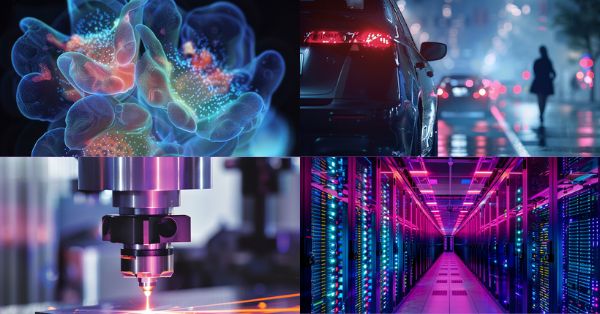Apr. 30, 2024

Ultraviolet Imaging
Light-based imaging, and particularly optical microscopy, benefits from the use of UV wavelengths, which address the fundamental need for improved resolution and specificity in such applications. With UV’s shorter wavelength, microscopy imaging can theoretically be used to view smaller particles and cells than traditional visible light microscopy. However, bulk optics for UV are rare, costly, and cannot offer the fine manipulation of UV light beams necessary for high-resolution imaging. This article introduces a bypass to this bottleneck, in the form of UV PICs. These integrated circuits combine all core optical functions into a single chip, thereby providing unprecedented control and manipulation of UV light. The article spotlights the processing and development of the PICs, as well as their usability for UV/suprerresolution microscopy applications, as well as less-traditional applications in quantum computing.
Key Technologies: UV microscopy, UV PICs, integrated optics, structured illumination microscopy, Lab-on-a-Chip, trapped ion quantum computing, UV imaging
LWIR/Thermal Imaging
With nighttime automotive-related pedestrian fatalities ascending to record highs in the U.S., IR imaging and its capabilities are an increasingly relevant technological consideration for safety regulators. And, as advanced driver-assistance system (ADAS) solutions continue to move the needle forward in the realm of autonomous mobility, designers of IR imaging and sensing technology are ripe to deliver their solutions to the automotive industry. This article looks at LWIR/thermal imaging as a solution for the automotive sector. Contributing editor James Schlett touches of sensor considerations, as well to the costs associated with system development and integration, SWIR versus LWIR advantages, autonomy, and imaging software.
Key Technologies: ADAS, LWIR imaging, thermal imaging, pedestrian safety, low-light imaging, LWIR camera sensors, camera filters, image reconstruction
Laser Materials Processing
In the evolving materials processing manufacturing landscape, femtosecond lasers are indispensable, offering unparalleled versatility and precision, and facilitating operations that are beyond the reach of more conventional laser technologies. The ability of these sources to emit high-intensity, ultrashort-pulse radiation has revolutionized materials micromachining, enabling precision fabrication across microelectronics, semiconductors, medical device manufacturing, automotive, and aerospace. For these applications, Light Conversion subject and technology experts examine femtosecond lasers' ability to achieve precise material removal and modification without causing thermal damage, a common issue with longer pulse or continuous-wave lasers; burst mode capability; and applications spanning micro-drilling, precision cutting, bulk dicing, and the creation of complex microstructures in hard and brittle materials. The utility of fs lasers in scenarios where traditional machining methods fall short of meeting advanced manufacturing requirements is also detailed.
Key Technologies: Femtosecond lasers, laser materials processing, industrial lasers, industrial laser applications, laser amplifiers, laser oscillators, fs fiber lasers
Optical Signal Processing
Success in the present, emergent era of silicon photonics and optical connectivity will be gauged both by time and place; applying the proper innovation to the proper use case will be cornerstone to how the industry deploys optical technology to solve data center and network challenges in the face of unabated data increase from AI workload proliferation. But even as the decades-long chase to smaller and faster transistors (driven by Moore’s Law) attempts to enmesh the optical signal processing revolution, delivering on that bargain isn’t keeping pace with the exponential data growth driving today’s performance demands. New Photonics' discusses the benefits to producing all-optical connectivity solutions within the framework of a greater data ecosystem, starting with signal processing. From the evolution of DSP-free linear pluggable optics and the power reductions that improved performance and removal of energy-hungry components offer, to the speed-of-light performance gains in time versus wavelength modulation, to the cost and yield advantages from design and production alignment with mature fabrication facilities, the all-optics paradigm shift poses a brightly lit roadmap to commercially viable photonics.
Key Technologies: Optical signal processing, silicon photonics, optical interconnects, linear pluggable optics, datacom, optical networking, integrated optics
EPIC Insights: Laser Microprocessing
Laser microprocessing includes all the laser processes used in the machining of very fine and/or small structures. Micrometer-scale precision and accuracy are required to obtain the desired structures and ensure functionality. The semiconductor and consumer electronics industries have taken benefit of the special advantages of lasers to perform different processes in wafers, OLEDs and displays, PCBs… Due to increasingly demanding requirements, new developments in laser sources and other components of the workstations are needed: ultra-short-pulsed lasers, mid-IR wavelengths, scanners, robots and movement stages, software, integration… Process monitoring is also gaining importance to control the laser process in-line and ensure the quality of the parts produced. EPIC's Antonio Castelo covers topical developments in laser and monitoring solutions for the semiconductor and consumer electronics industries in particular.
Key Technologies: Laser microprocessing, lasers for manufacturing, industrial lasers, IR imaging, spectral imaging, ultrashort pulse lasers, positioning equipment, semiconductor manufacturing
Photonic Fundamentals: SiC Optics
Integrated circuits made from silicon carbide (SiC) -- rather than traditional silicon chips -- will be key to improving the performance and range of electric vehicles. But SiC has very different mechanical, chemical, electronic, and optical characteristics from silicon. This puts a roadblock in the path of EV manufacturers because it means that many of the current IC fabrication processes don’t work in the same way with SiC, or don’t work at all. Singulation (wafer dicing) is a prime example: Mechanical sawing, which is the dominant method for singulating silicon wafers, doesn’t cleanly translate to SiC. Laser singulation offers promise, but work needs to be done to characterize the laser/material interaction and to identify the optimum sources and process parameters. MKS-Spectra-Physics' Jim Bovatsek overviews a results summary of successful SiC wafer scribing tests performed with UV picosecond pulse laser system. It examines how various parameters influence results, with a particular emphasis on the use of pulse bursts.
Key Technologies: SiC Optics, picosecond lasers, industrial picosecond lasers, surface topography, picosecond UV lasers, thermal power sensors, laser power meters.
Download Media Planner